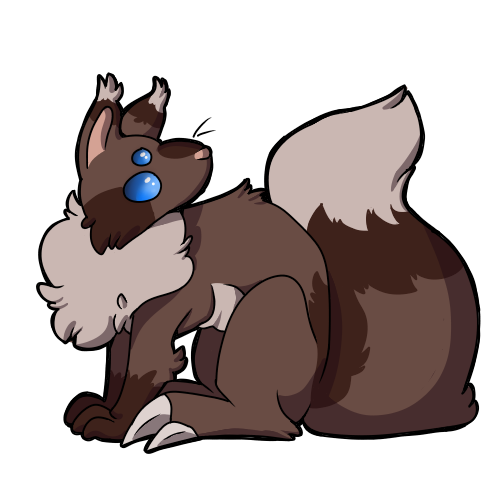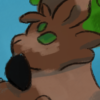[Cosmosdex] The Universal Encyclopedia
[Cosmosdex]
Squiget
Puzzle Squirrel / Hide Yo Keys
Squiget

Art by, Stumpios
- Strength-2
- Intelligence-1
- Charisma-1
- Endurance-2
- Agility-6
- Luck-5
Danger Level: Safe
Likes: Praise, Hiding belongings, Engagement
Dislikes: People cheating their "puzzles", Mud, Hot climates
Attack Method: Squigets will try to find other squigets to gang up on the foe. If none are available, the squiget will use its sharp claws to dispatch the opponent.
Attributes
Environment: While originally found in temperate forests, urban cities are becoming a more common environment for them.Lifespan: 20 years
Size: 2 ft tall
Diet: Fruit, Insects
Bodytype: Tailed Bipedal
Type: Mammal
Rarity: Common
Original Creator: Stumpios
Physical Description
Squigets are rather large for a rodent, standing bipedally at about the size of an average housecat. Their short, fluffy fur comes in typically earthy tones, with greys, browns, and bright reds being the most common. Their eyes tend to be much more varied, coming in almost any color that can be seen in nature, though shades of green and blue are the most common. Despite having four legs, their front legs aren't long enough for squigets to comfortably run quadrupedally. Instead, these front arms are mainly used for grabbing and climbing.
Some of the main features of a squiget are their thick manes, sharp back claws, and broom-like tail. While seemingly quite generic features, they're vital in the creature's job as a teaching item for young I-classes. The claws serve the simple purpose of leaving marks on soft surfaces, which act as clues in this faux crime scene. Their fluffy manes and tails serve a similar purpose of leaving tufts of fur, though the tail offers the additional benefit of hiding these clues for harder challenges.
It should be noted, that in spite of having pouches, squigets aren't marsupials. These pouches have never been recorded to be used for hosting young. Instead, squigets will carry offspring in their manes or tails, seemingly due to the softer fur.
Behavior
Considering that squigets were modified with the aim of being I-class capture creatures, they can be difficult for the more inexperienced pet owners. Being prone to hiding and hoarding their owners' belongings, and additionally being difficult to befriend, squigets certainly aren't easy pets. Though, this hardly seems to deter those who want one.
One of the staple traits of squigets is their tendency to hide things. This comes down to their actual intent of training I-classes to do their namesake of investigation. Squigets will gather up anything they deem as "valuable," and hoard it in a set location. This location, thankfully, isn't particularly hard to track down, due to the modified biology of these troublesome rodents. Between the shedding fur and claw marks, it won't take more than about twenty minutes to track down the stash of belongings.
At first, at least. As their stashes start to get discovered and raided, squigets will naturally begin to cover up their own tracks. This may mean less fur in one's house, or less clawmarks on that freshly waxed flooring, but it also means there's less of a chance that someone may, say, find their keys before they're late to work.
Thankfully, these behaviors can be trained away with some patience, and giving a squiget its own hoard of objects to scatter around its living space. It's not a guaranteed cure-all, but it will at the very least take the misplacing of valuable items from a weekly occurance to an occasional inconvenience.
While training a squiget, it's likely they'll start to be more outwardly friendly to an owner, too. This is also intentional, in the way of encouraging I-classes to befriend a subject of investigation rather than scare them. It takes effort to win the trust of a squiget, but the effort and affection are surely repaid by those who seek it.
Due to how receptive squigets are to training and stimulation, it should be clear these are a more "intelligent" fauna. Well, as intelligent as a non sapient animal can be. Due to this, they require a high amount of stimulation through toys and attention. Having two squigets also works, though only if both are trained. Having one untrained squiget is likely to undermine the training of the other, and encourage troublesome behaviors that had been long trained away.
Subspecies
Magpies: With a specific interest in one type of item, magpie squigets can be used to practice different types of crimes, such as robberies, or even missing persons. They're significantly easier to train, and have been modified to have specific markings based on their "specialty".
Runners: Still keeping their rodent physique, runner squigets are made for tracking. Their front and hind paws not only both possess paws, but special ink glands that can be used to mark the path they traveled. This allows a squiget to run after a criminal, or trail, while the investigator follows from behind. In addition to these pathmaking features, runners have significantly shorter tails, to prevent tripping while in high-speed chases.
Special
Puzzle Makers: Designed to challenge young I-classes, squigets can create a practice "crime scene" when given enough things to hide. Clues are provided in the way of shed fur, claw marks, and, in particularly beginner cases, pawprints. Over time, as a squiget picks up on its owner's habits, these "crime scenes" increase in difficulty. Using their tails and pouches, a squiget will begin to remove evidence of their hoards, creating a harder puzzle for their owners to solve.
Trivia
• A group of squigets is called a sudoku.
• In a domestic environment, it's not uncommon for a squiget to develop a favorite type of item. While most squigets will have a variety regardless of favorites, those with a favorite type of item may have a hoard specifically dedicated to it.
• Due to being rather dexterous and easy to train, squigets are particularly receptive to task training. Who doesn't want a giant squirrel to fetch their newspaper?

